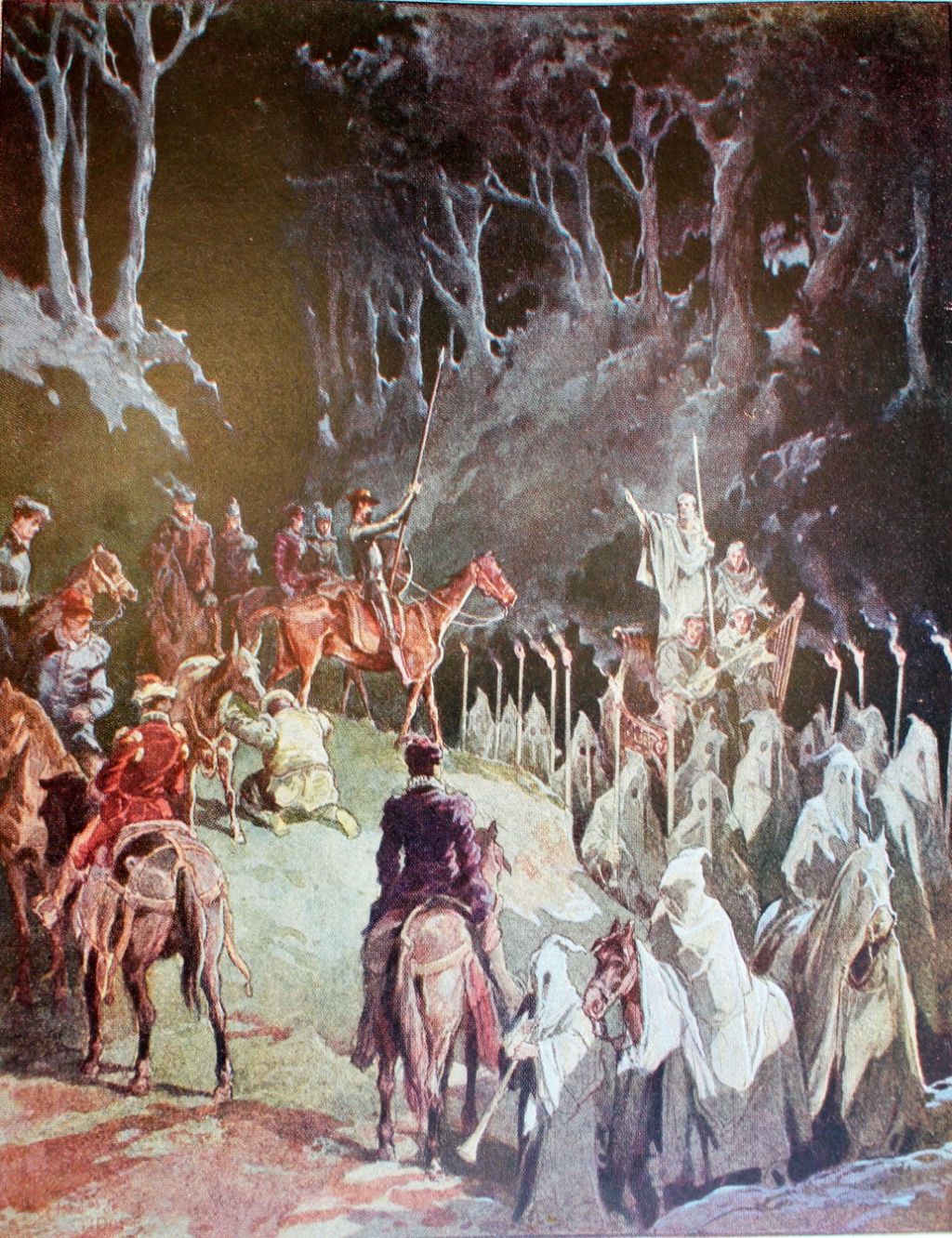In the previous episode, Don Quixote and Sancho Panza were eating as guests of the Duke and Duchess, when their chaplain’s speech made the knight seethe with anger. He rose and delivered a searing riposte, which led to the churchman storming out. Unexpectedly, maids then arrived to wash and lather Don Quixote’s beard, a peculiar procedure they also performed on the Duke. Sancho Panza, though, was attended to by scullions who weren’t as pleasant. His master and the Duchess discussed the nobility of the lady Dulcinea, and when they rose from the meal the Duchess invited Sancho to talk with her in a cool room. She elicited an account of what had actually happened at the Cave of Montesinos before the squire went away to sleep. The Duchess went to tell her husband what Sancho had to say, and to devise a trick to play on Don Quixote.
Once the Duke and Duchess had carefully briefed their servants, they took Don Quixote and his squire hunting. While Sancho was content to wear a fine green outfit they had given him, the knight insisted on his armour so that it would prepare him to return to his knightly duties. His squire turned down the offer of a horse, though, and joined the large group of beaters on his donkey.
When they arrived at a wood between two hills, all apart from Sancho dismounted, the Duchess poised ready to spear a passing wild boar. The noise of the hunt was deafening, and soon drove a boar straight at the party. Don Quixote stepped forward to meet it with his sword, as did the Duke and Duchess with their spears. But Sancho jumped from his donkey and ran away as fast as he could to climb a tree. As we was making his way up its branches, one broke and he fell, only to be snagged by a lower branch and suspended there.
By then the boar had been well and truly speared. When Don Quixote realised that the noise was the shouting of his squire, he went over to release him. The party carried the dead boar to marquees where they took lunch.

Sancho was upset at the tears in the fine clothes he was wearing, blaming the hunt. After they had eaten they returned to the wood to hunt through the rest of the day and that night.
Once it was dark the wood came alive with fires, the calls of bugles, and the cries of Moors going into battle. The Duke and Duchess were surprised, while the knight was struck dumb and his squire terrified. A messenger then appeared before them, looking like the devil himself. When the Duke challenged him he said he was looking for Don Quixote, as there were six troops of enchanters riding through the wood, bringing the lady Dulcinea on a chariot, with instructions as to how she could be disenchanted. The messenger then rode off with a ghostly blast on his horn.

Don Quixote told the Duke that he’d wait for his lady. As he did the night grew darker, the flitting fires and sounds even more disturbing, until battles were raging all round them. Sancho fainted away with fear, and had to be brought to by splashing water on his face. Just as he opened his eyes an ox cart with creaking wheels approached, being driven by two demons. On it was seated an old man with a long white beard, who declared that he was the sage Lirgandeo.

As that cart rolled off into the night, a second approached, this time carrying the sage Alquife. On the third cart was a powerful man who said he was the enchanter Arcalaus. Those three carts came to a halt nearby, and the party heard gentle and harmonious music.


Next came a large chariot drawn by six mules and bearing penitents dressed in white and holding torches. Seated on a high throne in the middle was a veiled maiden in her late teens. Next to her was the figure of death, who announced that he was Merlin the wizard, and told them that to disenchant the lady Dulcinea the squire had to lash himself on his bare buttocks three thousand three hundred times, which would break the spell.
Sancho immediately refused, so his master told him that he’d lash him twice that amount, but Merlin insisted that the lashing must be of Sancho’s free will and not enforced by someone else. The maiden then put the persuasive argument that such lashing wasn’t unreasonable in the circumstances. Sancho was unpersuaded, but the Duke put his promised governorship on the line, forcing the squire to ask for a couple of days to think about it.
Merlin said that his decision had to be made now or never, and eventually Sancho agreed to accept his penance so that, once he reached the required number of lashings, the lady would be disenchanted. Don Quixote embraced and kissed his squire, and the Duke and Duchess were delighted. The chariot moved on, as the first light of dawn was seen in the sky. The Duke and Duchess led the party back to their castle, relishing the success of their first trick pulled on Don Quixote and Sancho Panza.
That completes the thirty-fifth chapter of the second book of Don Quixote.
Further reading
Wikipedia
List of characters
English translation by John Ormsby (1885)
Miguel de Cervantes Saavedra, trans John Rutherford (1604, 2000) Don Quixote, Penguin, ISBN 978 0 140 44909 9.
Roberto González Echevarría (2015) Cervantes’ Don Quixote, Yale UP, ISBN 978 0 300 19864 5.
Roberto González Echevarría (ed) (2005) Cervantes’ Don Quixote, A Casebook, Oxford UP, ISBN 978 0 19 516938 6.

